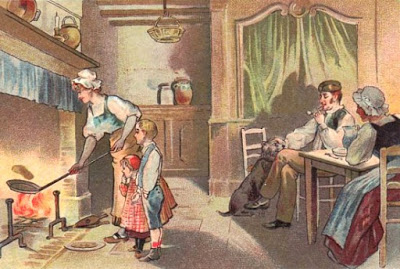Filled with strawberries, sprinkled with sugar or dripping with cheese, crêpes are tempting to eat. They also have a fascinating history.
It all begins with the pancake, which first appeared as a flat, unleavened bread as early as prehistoric times.

Almost every country has its own version of the crêpes, but it was France’s Brittany region where the tools and techniques were created and perfected.
Where Does The Word Crêpe Come From?
The word comes from the Latin term crispus which meant crisp. In France, crêpe is spelled with a character known as the circumflex or ˆover the first “e”.
How Do You Pronounce “Crêpe” Like A Frenchman Or Woman?
Every time you order a “crape,” “creep” “crap”, “creepy” or “crépé” in one of our cafés, we know what you mean BUT, when in France, the way to pronounce “crêpe” is to rhyme with “step” or “yep”.
The Early Days
In the early days of the crêpe, white flour was an expensive product reserved only for royalty, that’s why savory crêpes were traditionally made with buckwheat, an easy to grow plant. As farmers became wealthier, they began to enjoy sweet white flour crêpes as an after-dinner treat or with coffee for breakfast.
“…sprinkled with sugar and eaten hot, they form an exquisite dish. They have a golden hue and are tempting to eat. Thin and transparent like muslin, their edges are trimmed to resemble fine lace. They are so light that after a good dinner, a man from Agen is still willing to sample three or four dozen of them! Crêpes form an integral part of every family celebration. Served with white wine, they take pride of place on all joyful occasions.”
Anatole France, French novelist, ‘Le Temp’
The Crêpe Suzette
In Paris and the South of France, crêpes were essentially a dessert served in fine restaurants thanks to Henri Charpentier who in 1895, as a young man, went to Monaco to work for the Café de Paris with his uncle, the famous Chef Escoffier.
One evening, the Prince of Whales requested a crêpe for dessert. Henri raced to the kitchen and prepared a crêpe with orange sauce flambée.
He named it Suzette in honor of the beautiful lady who accompanied the Prince.
The rest is history … The Crêpe Suzette became the most celebrated French dessert.
Le Jour Des Crêpes
La Chandeleur is celebrated 40 days after Christmas on February 2nd. Chandeleur means ‘the return of the light’ because it symbolizes that spring is on its way.
February 2nd is also known as le jour des crêpes (‘the day of crêpes’) because the crêpe looks like the sun and reminds us that the cold winter will soon be over.

A fun tradition for La Chandeleur is to flip a crêpe with your right hand while holding a gold coin with your left hand for a prosperous year. The trick is to make sure that the crêpe lands correctly in the pan.
The Crêpe Today
Crêpes are constantly being re-imagined in kitchens around the world and in Miami. Since 1992, CrêpeMaker has taken their expertise and experience to create hand held crêpes filled with fresh, healthy food combinations, made right in front of customers that would satisfy the heartiest of appetites and the sweetest tooth.
How Do You Eat A Crêpe?
CrêpeMaker Etiquette:
Grasp the crêpe with one hand.
Peel the paper back with the other hand as you eat it.
At CrêpeMaker, eating with your hands is good manners, forks and knives are not recommended.
Licking your fingers is tempting but … questionable!

